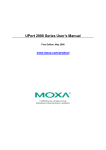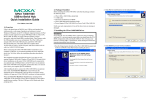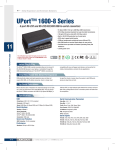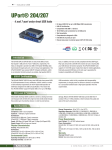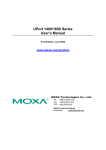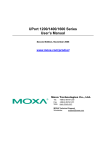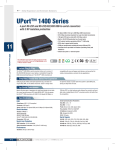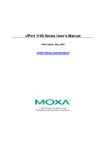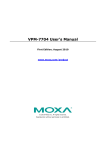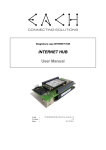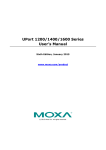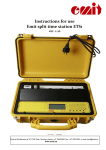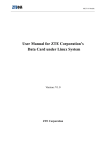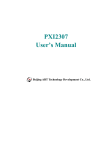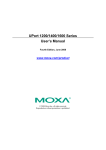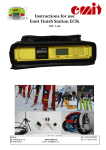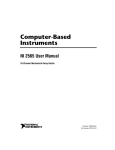Download UPort 2000 Series User`s Manual
Transcript
UPort 2000 Series User’s Manual Second Edition, December 2012 www.moxa.com/product © 2012 Moxa Inc. All rights reserved. UPort 2000 Series User’s Manual The software described in this manual is furnished under a license agreement and may be used only in accordance with the terms of that agreement. Copyright Notice © 2012 Moxa Inc. All rights reserved. Trademarks The MOXA logo is a registered trademark of Moxa Inc. All other trademarks or registered marks in this manual belong to their respective manufacturers. Disclaimer Information in this document is subject to change without notice and does not represent a commitment on the part of Moxa. Moxa provides this document as is, without warranty of any kind, either expressed or implied, including, but not limited to, its particular purpose. Moxa reserves the right to make improvements and/or changes to this manual, or to the products and/or the programs described in this manual, at any time. Information provided in this manual is intended to be accurate and reliable. However, Moxa assumes no responsibility for its use, or for any infringements on the rights of third parties that may result from its use. This product might include unintentional technical or typographical errors. Changes are periodically made to the information herein to correct such errors, and these changes are incorporated into new editions of the publication. Technical Support Contact Information www.moxa.com/support Moxa Americas Moxa China (Shanghai office) Toll-free: 1-888-669-2872 Toll-free: 800-820-5036 Tel: +1-714-528-6777 Tel: +86-21-5258-9955 Fax: +1-714-528-6778 Fax: +86-21-5258-5505 Moxa Europe Moxa Asia-Pacific Tel: +49-89-3 70 03 99-0 Tel: +886-2-8919-1230 Fax: +49-89-3 70 03 99-99 Fax: +886-2-8919-1231 Moxa India Tel: +91-80-4172-9088 Fax: +91-80-4132-1045 Table of Contents 1. Introduction ...................................................................................................................................... 1-1 Overview ........................................................................................................................................... 1-2 Package Checklist ............................................................................................................................... 1-2 Product Features ................................................................................................................................ 1-2 Product Specifications ......................................................................................................................... 1-3 Panel Layout ...................................................................................................................................... 1-4 Dimensions ........................................................................................................................................ 1-4 2. Driver Installation ............................................................................................................................. 2-1 UPort’s USB Usage Limitation ............................................................................................................... 2-2 Installing the Windows Driver ............................................................................................................... 2-2 Connecting the Hardware ............................................................................................................. 2-5 Installing the Driver for the Converter............................................................................................ 2-5 Installing the Driver for the Ports .................................................................................................. 2-8 Configuring the Ports ................................................................................................................. 2-11 Uninstalling the UPort 2000 ........................................................................................................ 2-13 Advanced UPort 2000 Driver Functions ......................................................................................... 2-14 Uninstalling the Driver ............................................................................................................... 2-18 Linux Kernel 2.6.x ............................................................................................................................ 2-19 Installing the Linux Driver .......................................................................................................... 2-19 Loading the Moxa Driver ............................................................................................................ 2-19 Unloading the Moxa Driver ......................................................................................................... 2-20 Removing the Moxa Driver and Utility Files ................................................................................... 2-20 Using the mxustty Utility ............................................................................................................ 2-20 MAC OS X Driver .............................................................................................................................. 2-20 Installing the MAC OS X Driver.................................................................................................... 2-21 Verifying the Installation ............................................................................................................ 2-24 Using the Utility ........................................................................................................................ 2-25 3. Pin Assignment ................................................................................................................................. 3-1 1 1. Introduction Moxa’s UPort 2000 Series of entry-level USB-to-serial converters are used to add 2 or 4 serial ports to a PC through the PC’s USB port. The UPort 2000 converters are compatible with both new and legacy RS-232 devices, and are a perfect solution for mobile, instrumentation, and point-of sale applications. The UPort 2000 Series includes two models: • UPort 2210 2-port RS-232 USB-to-serial converter • UPort 2410 4-port RS-232 USB-to-serial converter In this manual, UPort 2000 is used in examples and explanations to represent either the UPort 2210 or the UPort 2410. The following topics are covered in this chapter: Overview Package Checklist Product Features Product Specifications Panel Layout Dimensions UPort 2000 Series Introduction Overview UPort 2000 Series products are easy to install and use. After installing the drivers on your PC, connect the UPort to your computer, plug in your serial devices, and you’re ready to go. Programming is NOT required, and you do not need to worry about IRQs, configuring a board, power requirements, or connection schemes. UPort 2000 Series products are compliant with USB 1.1, and 2.0 specifications, and meet the 480 Mbps high-speed requirement of Hi-Speed USB 2.0. Using your computer’s USB ports to connect serial devices reduces the total cost of ownership, investment in hardware, and long term management and integration costs. Package Checklist Moxa’s UPort 2000 Series products are shipped with the following items: • UPort 2210 or 2410 USB-to-serial converter • 1 USB cable • Document and Software CD-ROM • UPort 2000 Series Quick Installation Guide (printed) NOTE: Notify your sales representative if any of the above items are missing or damaged. Product Features UPort 2000 Series products have the following features: • Hi-Speed USB 2.0 supported for up to 480 Mbps transmission through the USB port • Additional I/O or IRQ not required • Serial transmission rate up to 921.6 Kbps • Built-in 15 KV ESD protection • Windows 2000/XP/2003/Vista/2008, Linux Kernel 2.6.x drivers supported • Easy maintenance with LED display and management software • COM port assignments maintained across different PCs 1-2 UPort 2000 Series Introduction Product Specifications USB Compliance USB 1.1/2.0 compliant Connector USB type B Speed High speed 480 Mbps Serial Interface Number of Ports UPort 2210: 2 UPort 2410: 4 Serial Standards RS-232 Connectors DB9 male Serial Line Protection ESD Protection 15 KV embedded Performance Baudrate 50 bps to 921.6 Kbps Serial Communication Parameters Data Bits 5, 6, 7, 8 Stop Bit 1, 1.5, 2 Parity None, Even, Odd, Space, Mark Flow Control RTS/CTS, XON/XOFF I/O Address Assigned by BIOS IRQ Assigned by BIOS FIFO 16 bytes Serial Signals RS-232 TxD, RxD, RTS, CTS, DTR, DSR, DCD, GND Driver Support Operating Systems Windows (2000, XP x86/x64, 2003 x86/x64, Vista x86/x64, 2008 x86/x64), Linux Kernel 2.6.x Pysical Characteristics Housing Plastic Dimensions UPort 2210: 70 x 35 x 120 mm (2.76 x 1.38 x 4.72 in) UPort 2410: 80 x 35 x 185 mm (3.15 x 1.38 x 7.28 in) Environmental Limits Operating Temperature 0 to 55°C (32 to 131°F) Operating Humidity 5 to 95% RH Storage Temperature -20 to 75°C (-4 to 167°F) Regulatory Approvals EN55022 Class B, EN55024, EN61000-3-2, EN61000-3-3, IEC 61000-4-2, IEC 61000-4-3, IEC 61000-4-4, IEC 61000-4-5, IEC 61000-4-6, IEC 61000-4-8, IEC 61000-4-11, FCC Part 15 Class B Warranty Warranty Period 5 years Details See www.moxa.com/warranty 1-3 UPort 2000 Series Introduction Panel Layout UPort 2210 UPort 2410 Dimensions UPort 2210 1-4 UPort 2000 Series Introduction UPort 2410 1-5 2 2. Driver Installation In this chapter, we use Windows XP to illustrate how to install the UPort 2000 USB-to-serial converters. The procedures for Windows 2000/2003/2008 and Windows Vista are essentially the same. We recommend installing the UPort 2000 Series driver first, before connecting the UPort 2000 USB-to-serial converter to your computer’s USB port. The following topics are covered in this chapter: UPort’s USB Usage Limitation Installing the Windows Driver Connecting the Hardware Installing the Driver for the Converter Installing the Driver for the Ports Configuring the Ports Uninstalling the UPort 2000 Advanced UPort 2000 Driver Functions Uninstalling the Driver Linux Kernel 2.6.x Installing the Linux Driver Loading the Moxa Driver Unloading the Moxa Driver Removing the Moxa Driver and Utility Files Using the mxustty Utility MAC OS X Driver Installing the MAC OS X Driver Verifying the Installation Using the Utility UPort 2000 Series Driver Installation UPort’s USB Usage Limitation 1. A maximum of 4 UPort 2000 converters can be connected to one PC host. Connecting more than 4 UPort 2000 converters will put a strain on system resources, and could cause the computer to become unstable. 2. We recommend connecting the UPort 2000 directly to your PC’s USB port. 3. Although your UPort 2000 supports USB 1.1, we recommend using a USB 2.0 host controller or HUB to get the best and most stable performance. Installing the Windows Driver 1. Run the Setup Wizard located on the UPort 2000 Series Document and Software CD-ROM. Click Next to start installing the driver. 2. Click Next to install the driver in the indicated folder. 2-2 UPort 2000 Series Driver Installation 3. Click Next to create the program’s shortcuts in the indicated folder. 4. Click Install to proceed with the installation. 2-3 UPort 2000 Series Driver Installation 5. The next window that opens cautions you that although this software has not passed Windows logo testing, the driver has already been tested and shown that it can support the Windows operating system. Click Continue Anyway to proceed. 6. Click Finish to complete the driver installation. 2-4 UPort 2000 Series Driver Installation Connecting the Hardware Please install the driver before connecting the UPort 2000 to your PC’s USB port. See the previous section for details. Connecting to a Serial Device Use the proper serial cables to connect your serial devices to the UPort 2000’s serial ports, which support the RS-232 interface. The UPort 2000’s serial ports use DB9 male connectors with standard RS-232 pin assignment. LED Indicators The UPort 2000 has LEDs on the front panel. The “Active” LED indicates the power status, and the “TxD” and “RxD” LEDs indicate the transmission status of each serial port. In addition, when you click “Locate” for a particular UPort, that UPort’s “Active” LED will blink to indicate its location. LED Name Active TxD, RxD LED Color LED Function Green Power is on Off Power is off, or power error condition exists Orange Port is receiving data from attached device Green Port is transmitting data to attached device Off No data is being transmitted or received Installing the Driver for the Converter 1. After connecting the USB cable from UPort to host the PC, Windows XP will automatically detect the new UPort, and the Found New Hardware balloon will open in the bottom right corner of the Windows desktop. 2. Select No, not at this time. Click Next to start the installation. 2-5 UPort 2000 Series Driver Installation 3. Select Install the software automatically (Recommended), and then click Next to continue. 4. Wait while the installation wizard searches for the correct drivers. The next window that opens cautions you that although this software has not passed Windows logo testing, this driver has already been tested and shown that it can support the Windows operating system. Click Continue Anyway to proceed. 2-6 UPort 2000 Series Driver Installation 5. The next window shows the model name of the board, and indicates that Windows has completed the driver installation. Click Finish to proceed with the rest of the installation procedure. 6. Open the Windows Device Manager to check that the installation was successful. The UPort USB-to-serial converter should appear under Multi-port serial adapters. 2-7 UPort 2000 Series Driver Installation Installing the Driver for the Ports 1. The Found New Hardware Wizard window will open to help you install the driver. This window will offer to connect to the Windows update site to search for a driver. Select No, not at this time and then click Next to continue. 2. Select Install the software automatically (Recommended), and then click Next to continue. 2-8 UPort 2000 Series Driver Installation 3. Wait while the installation wizard searches for the correct drivers. The next window that opens cautions you that although this software has not passed Windows logo testing, this driver has already been tested and shown that it can support the Windows operating system. Click Continue Anyway to proceed. 4. Wait while the driver is installed. 2-9 UPort 2000 Series Driver Installation 5. After all files have been copied to the system, the Completing the Found New Hardware Wizard window will open to indicate that it has finished installing driver. Click Finish to proceed with the rest of the installation. 6. Repeat Step 1 through Step 5 for each of the remaining ports (1 port for the UPort 2210, and 3 ports for the UPort 2410). 7. The Found New Hardware balloon will reappear to inform you that the hardware was installed successfully. 2-10 UPort 2000 Series Driver Installation Configuring the Ports After the driver has been installed, use Windows’ Device Manager to configure the UPort serial ports. 1. With the System Properties window open, click on the Hardware tab, and then click on Device Manager. 2. Expand the Multi-port serial adapters tab, right click MOXA UPort 2210 (or 2410), and then click Properties to open the UPort’s configuration panel. 2-11 UPort 2000 Series Driver Installation The Ports Configuration page settings are described below. Port Settings Auto Enumerating COM Number If the Auto Enumerating COM Number checkbox is checked, COM numbers will be assigned automatically and in sequence to the ports. E.g., COM3 to Port 1, COM4 to Port 2, etc. If you do not enable this check box, only the COM number for the selected port will be changed to the COM number listed in the drop-down list box. Enable this function if you want to configure the UPort’s serial ports with sequential COM numbers. Friendly Name Setting Factory Default Necessity 1 to 20 characters Moxa UPort COM Optional (E.g., UPort 2210) Users can assign a Friendly name to each of the UPort 2000’s serial ports. The friendly name gives users an easy way to identify the serial devices connected to the UPort’s serial ports. If you enable set the change to all ports and then click OK, the same friendly name will be assigned to all ports. Fast Flush Setting Factory Default Necessity Enable/Disable Enable Required The Fast Flush setting is designed for applications that call the Win32 PurgeComm() function before reading or writing data. If Fast Flush is not enabled, then instead of just flushing the local buffer, the UPort’s driver will query the UPort’s firmware repeatedly in a short period of time to make sure that no data is queued in the UPort’s firmware buffer. For this reason, you may find that your PC’s native COM ports respond much more quickly when making PurgeComm() function calls compared to the UPort’s serial ports. In this case, enable Fast Flush (enabled by default) to speed up the reaction of the UPort’s serial ports. Interface Setting Factory Default Necessity RS-232 RS-232 Required 2-12 UPort 2000 Series Driver Installation Other Settings Reset default If you click the Reset default button, all the settings will return to the factory default settings: COM Number: <Assign available COM number automatically> Fast Flush: Enable Interface: RS-232 Help Click on Help to open the UPort 2000’s online help utility. Locate Use the Locate function to determine the location of a particular UPort 2000. This function is particularly useful when two or more UPorts are installed on the same PC. The Locate function will cause the selected UPort 2000’s LED to flash, and UPort 2410 will sound the buzzer. Uninstalling the UPort 2000 To remove a particular UPort 2000 from you PC, simply remove that UPort 2000 from the Device Manager. However, the UPort driver will NOT be removed so that other UPort 2000 converters connected to the PC will continue to work properly. 1. To uninstall the UPort 2000, click Start Settings Control Panel System, select the Hardware tab, and then click Device Manager. 2-13 UPort 2000 Series Driver Installation 2. Expand the Multi-port serial adapters tab, right click MOXA UPort 2210 Series, and then click Remove to uninstall this UPort 2000. A window will pop up to confirm that you want to remove this UPort. 3. Click OK to continue uninstalling the UPort device. The UPort device will be removed from the list of Multi-port serial adapters. Advanced UPort 2000 Driver Functions Moxa’s UPort 2000 Series Utility gives users a convenient tool for configuring and maintaining products from the UPort 2000 Series. In this section, we introduce the difference between “Normal COM Mode” and “Fixed-base COM Mode”. The Default Setting is Normal COM Mode Each of Moxa’s UPort 2000 products comes with a unique serial number to register with the Windows OS. If your UPort is reconnected to a different USB port, the host will recognize that it’s the same UPort and then utilize the same COM port numbers. 2-14 UPort 2000 Series Driver Installation To use Normal COM Mode, be sure to the leave Enable Fixed-base COM Mode unchecked. For the sake of argument, assume that we are using two UPort 2210 USB-to-serial converters configured for “Normal COM Mode.” Each UPort 2210 has two serial ports. When you plug UPort D1 (please refer to the figure below) into your computer, your computer’s operating system assigns the first two available COM numbers (COM3 and COM4 in this example) to the UPort’s serial ports. If you now plug UPort D2 into another of your computer’s USB ports, your computer will again assign the first two available COM numbers (COM5 and COM6 in this example). At this point you can use the UPort utility to assign different COM numbers to these ports. COM3-COM4 1 2 (D1) COM5-COM6 (D2) The UPort’s “Normal COM Mode” has an added twist. Your computer uses the serial number of each UPort to record which COM numbers are assigned to the UPort’s serial ports. If one or both of the UPorts are unplugged from the computer, and then plugged back in, the COM numbers of the UPorts’ serial ports will be the same as they were before the UPorts were unplugged. For example, if both D1 and D2 are unplugged, and then D2 is plugged back in first, your computer will assign COM5 and COM6 to D2’s serial ports. When D1 is plugged back in, your computer will assign COM3 and COM4 to D1’s serial ports. COM3-COM4 2 1 (D1) COM5-COM6 (D2) In “Normal COM Mode” you can reset the COM numbers and configuration parameters of individual ports to the values needed for your application at any time. 2-15 UPort 2000 Series Driver Installation Fixed-base COM Mode Moxa’s UPort 2000 series provides a unique fixed-base COM function that allows users to set a specific initial COM port number. Regardless of which UPort is plugged into the host, the COM port numbers for the UPort’s serial ports will be numbered sequentially starting with the initial COM port number. To use “Fixed-base COM Mode,” be sure to check the “Enable Fixed-base COM Mode” check box. “Fixed-base COM Mode” allows users to specify which COM number will be assigned first. In addition, COM numbers are assigned sequentially, and are not tied to specific UPort converters. For example, assume that you have set COM10 as the first COM number that will be assigned. If UPort D1 is plugged into your computer first, your computer will assign COM10 and COM11 to the UPort’s serial ports. When UPort D2 is plugged in, the computer will assign COM numbers COM12 and COM13. COM10-COM11 1 2 (D1) COM12-COM13 (D2) 2-16 UPort 2000 Series Driver Installation If both UPorts are unplugged from the computer, and then UPort D2 is plugged back in, the computer will now assign COM10 and COM11 to the UPort’s serial ports. When UPort D1 is plugged back in, COM numbers COM12 and COM13 will be assigned the UPort’s serial ports. COM12-COM13 2 1 (D1) COM10-COM11 (D2) When “Fixed-base COM Mode” is enabled for the first time, all COM port numbers and serial port parameters will be reset to their default values. You can then set the COM numbers and configuration parameters to the values needed for your application. For example, let’s assume that before you enable “Fixed-base COM Mode” you set the parameters of the UPort 2000 as follows: Port Number: COM5 Friendly Name: POS Device 1 Fast Flush: Disable. If you now enable “Fixed-base COM Mode,” all parameters will be reset to their default values: Port Number: COM3 Friendly Name: MOXA UPort COM Fast Flush: Enable At this point you can set the COM numbers and other serial parameters to the values needed for your application. If you subsequently disable “Fixed-base COM Mode,” all parameters will be restored to the original settings: Port Number: COM5 Friendly Name: POS Device 1 Fast Flush: Disable In “Fixed-base COM Mode,” you can reset the COM numbers and configuration parameters of individual ports to the values needed for your application at any time. 2-17 UPort 2000 Series Driver Installation Uninstalling the Driver 1. To uninstall the driver, open the Windows’ Control Panel, and click Add/Remove Programs. 2. Select Moxa UPort 2000 Series Windows Driver Ver1.0, and then click the Remove button. Wait while the driver software is uninstalled. 2-18 UPort 2000 Series Driver Installation 3. Click OK to proceed with the un-installation procedure. Linux Kernel 2.6.x The Linux driver for Moxa’s UPort 2000 Series of USB-to-serial converters maps a Linux host’s ttyUSBxx ports to the UPort’s serial ports. Once the mapping has been established, Linux users and applications can connect to a device port as if it were a ttyUSBxx port. The Linux drivers have been tested with the majority of Linux distributions, including Linux kernel 2.6.x. Please check Moxa’s website (http://www.moxa.com) for the latest Linux kernel support information. In this section, we explain how to complete the following tasks: 1. Installing the Linux Driver 2. Loading the Moxa Driver 3. Unloading the Moxa Driver 4. Removing the Moxa Driver and Utility files 5. Using the mxustty Utility Installing the Linux Driver Obtain the driver file from the Document and Software CD, or from the Moxa website at http://www.moxa.com. To install and load the Linux drivers, execute the following commands from the Linux prompt: # mount /dev/cdrom /mnt # cd / # mkdir moxa # cd /moxa # cp /mnt/cdrom/<driver directory>/driv_linux2.6_uport2000_vx.x_build_yymmddhh.tgz /moxa # tar -xvfz driv_linux2.6_uport2000_vx.x_build_yymmddhh.tgz # cd /moxa/mxuport2000 # make install *Note: xx=version, yy = year, mm = month, dd = day, hh = hour Loading the Moxa Driver After installing the driver, you will be able to load the Moxa driver. The driver will be loaded automatically when you plug the UPort 2000 into your PC, or you can load the driver manually by issuing the following command: # modprobe mxuport2000 If the driver has loaded successfully, you should see a message such as the following: _MOXA UPort 2000 series driver ver 1.0 loaded successfully. You can verify that the driver has loaded by entering the following command: # lsmode For additional information, please refer to readme.txt file in the mxuport2000 directory. 2-19 UPort 2000 Series Driver Installation Unloading the Moxa Driver The driver will not unload automatically when you unplug the UPort 2000 from the PC. To unload the Moxa driver, you must remove it manually by issuing the following command: #rmmod mxuport2000 You can verify that the driver was unloaded by entering the following command: # lsmode For additional information, please refer to readme.txt file in the mxuport2000 directory. Removing the Moxa Driver and Utility Files To remove the Moxa driver and utility files, navigate to the path /moxa/mxuport2000, and then execute the following command: #make clean; Both the driver and utility files will be removed. Using the mxustty Utility To determine which UPort 2000 a particular serial device is connected to, use the “l” option with the “mxustty” utility. General usage: mxustty <option> device option = h to activate the help file option = l (ell) to locate a particular UPort device Use the following function call to locate the device ttyUSB3: # mxustty -l /dev/ttyUSB3 MAC OS X Driver The MAC OS X driver remains traditional in serial devices properties. There are two serial ports—Dial-in port, which waits for the carrier signal before opening, and the Callout port. Please check Moxa’s website (http://www.moxa.com) for the latest information and support for MAC OS X (version 10.4 or later). In this section, we explain how to complete the following tasks: 1. Installing the MAC OS X Driver 2. Verifying the Installation 3. Using the Utility 2-20 UPort 2000 Series Driver Installation Installing the MAC OS X Driver 1. Download the driver file from the Document and Software CD, or from the Moxa website at http://www.moxa.com. 2. Extract the files (driv_osx_uport2000_vX.Y_build_yymmddhh.mpkg, readme.txt, version.txt ). Double click the .mpkg file to start the installation. 3. Click Continue. 2-21 UPort 2000 Series Driver Installation 4. After reading the License Agreement, click Continue. 5. Click Agree to continue the installation. 6. The Select a Destination window will pop up. Click Continue. 2-22 UPort 2000 Series Driver Installation 7. You will see a pop-up window indicating how much space will be used for the installation. Click Install to continue. 8. Enter your password to allow Installer to make changes. Click OK to continue. 9. The installation will start automatically. 2-23 UPort 2000 Series Driver Installation 10. You will see a message saying that the installation is successful. Click Close to finish the process. Verifying the Installation Open the Applications > Utilities > System Profiler. 2-24 UPort 2000 Series Driver Installation Select USB under Hardware to open the USB Device Tree panel. Select MOXA Uport Device to display the information. Select Extensions under Software to open content panel. Select mxuport2000 to display the information. Using the Utility The MAC OS system has a built-in terminal emulator like the Linux system. Use the loopback cable to connect serial port 1 and serial port 2. 2-25 UPort 2000 Series Driver Installation Type screen /dev/cu.USB0 9600 to open 1st serial port. Type screen /dev/cu.USB1 9600 to open 2nd serial port. Data entered in the terminal emulator for serial port 1 will be displayed on the terminal emulator for serial port 2, and vice versa. The LEDs will blink as you type, showing that data is being transmitted and received between the two serial ports. 2-26 3 3. Pin Assignment The UPort 2210 has 2 ports RS-232 interface and UPort 2410 has 4 ports RS-232 interface. DB9 Male RS-232 Port for UPort 2210/2410 Pin RS-232 1 DCD 2 RxD 3 TxD 4 DTR 5 GND 6 DSR 7 RTS 8 CTS




































